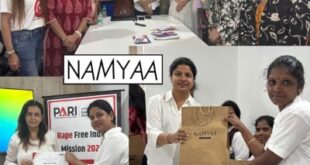- Women Village-Level Entrepreneurs from Haryana, Chhattisgarh, and Delhi Felicitated for Grassroots Contributions to Digital Education
- Village Level Entrepreneurs (VLEs) are primarily associated with the Common Service Centre (CSC) scheme in India, which is designed to bridge the digital divide and empower rural communities by providing various government and non-government services.
New Delhi, July 17, 2025: Roadmap for expanding access to higher education through digital platforms was recently discussed at a national event on “Empowering Rural Women Through Digital Education and Entrepreneurship”. The programme focused on increasing participation among women and youth in rural areas, with the broader goal of achieving 100% Gross Enrollment Ratio (GER) in India by 2050.
A key highlight of the event was the felicitation of three women Village-Level Entrepreneurs (VLEs) for their work in enabling last-mile digital empowerment. Ms. Sonu Bala, from Rewari, Haryana; Ms. Anchal Agicha, from Bilaspur, Chhattisgarh; and Ms. Sarita Singhani, from Southwest District, Delhi, were recognised for their contributions as women entrepreneurs operating through CSCs. Their work in supporting access to digital services, online education, and local outreach reflects the vital role of women in advancing community-led transformation.
Mr. Sanjay Kumar Rakesh, Chairman, CSC Academy; Mr. Ashish Khosla, Founder and President of Shoolini University; and Mr. Pallav Tiwari, Programme Specialist, Passport to Earning, UNICEF India, led a focused discussion on reducing the enrollment gap through digital infrastructure, skill-based learning, and grassroots partnerships. They highlighted how women’s involvement and flexible online programs can create equitable pathways to education and employment across India.
Mr. Ashish Khosla, Founder and President, Shoolini University, said, “Women are the backbone of our society, and their education is the first step toward true equality. When a woman is educated, a generation is transformed. Today, only 24% of women are part of India’s workforce — this must change. With access to the right support, skills, and confidence, women can lead, innovate, and shape a stronger India.”
Mr. Sanjay Kumar Rakesh, Chairman, CSC Academy, said, “The core purpose of CSCs goes beyond service delivery — it is about creating real opportunities for people in their own communities. Our partnership with Shoolini University supports this vision by making quality, professional education accessible to women and youth in villages. Education that leads to employability has the power to change the financial future of a family, and we see this as a practical step in that direction.”
Mr. Pallav Tiwari, Programme Specialist, Passport to Earning, UNICEF India, stated, “While films today portray women as leaders and professionals, the reality on the ground tells a more complex story. With workforce participation still below 25%, most women—especially in rural India—remain confined to informal and low-paying jobs. Through our collaboration with CSC, we aim to change that by taking skilling to the last mile. Even a 10-hour course can be the starting point of transformation. The journey has begun, but we must go much further.”
The event also highlighted the collaboration between Shoolini University and the Common Services Centres (CSC), formalised through a Memorandum of Understanding signed earlier this year. The partnership enables students to access Shoolini’s online and distance learning programs through CSC’s nationwide network of centres. These centres provide services including digital access, academic mentorship, and admission support. As part of this initiative, Shoolini University announced a 40% scholarship exclusively for deserving women applicants for its online degrees.
The event reflected a collaborative approach to addressing key gaps in education access. It underlined the role of digital platforms, local leadership, and targeted support in driving long-term impact and contributing to India’s goal of achieving 100% Gross Enrollment Ratio by 2050.
 Newspatrolling.com News cum Content Syndication Portal Online
Newspatrolling.com News cum Content Syndication Portal Online







